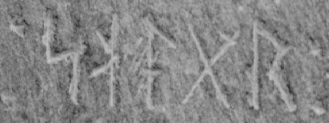"Havero" runes on a wooden stave (measuring stick) in a museum in Medelpad, Sweden. How widespread were the runes practiced, and how long did they exist going back in time?
For that matter, how long did the Larsson Papers runes--similar to the "Kensington Runes"--exist before the late 1800s, and how widespread were they used? No one today seems to know for sure...probably because of the runes' apparently secretive history.
But Magnus Kallstrom, a runologist and associate professor of Scandinavian languages at the Swedish National Heritage Board, seems to be quite certain about the issue at hand, believing the Kensington Runestone is a hoax. In an article from the Swedish National Heritage Board, updated about a year ago, he boldly claims, "There was no runic system like this in the Middle Ages." (The Kensington Runes are self-dated to 1362.) He went on to say, "It was probably a secret written language that was created and handed down by a certain group of people."
At any rate, the Swedish National Heritage Board article was sure of its findings--and smug in its outlook: "We may never know who carved the Kensington stone itself. Possibly it was Olof Ohman, possibly someone close to him. Another possibility is that it was someone who wanted to make fun of Ohman. However, it is becoming increasingly clear that the knowledge of the Kensington runes came to America with the wave of migration in the late nineteenth century from the region of Hälsingland and Medelpad."
Hhmmm...naturally, I now can't help wondering about the likelihood that the medieval-era carver of the KRS was familiar with the Halsingland region of Sweden. For someone like me--an unashamed believer in the KRS's authenticity, it must be that the "newly-found," so-called Kensington Runes from Sweden were utilized going back to 1362 Minnesota...and I don't think the runes were hoaxed in Sweden after the KRS's discovery on Runestone Hill in 1898. Rather, I think the Kensington Runes came to Minnesota in 1362, and then late 19th century emigrations from central Sweden may have once again brought the rare runes to Minnesota. How could it be otherwise, if the KRS is genuine...and I believe it is.
Here is some random--yet spot-on--wisdom I just gleaned from the internet, to help prove my point of the KRS's authenticity. A similar study might be made of the so-called Dotted R, in order to show how ignorant some KRS researchers are in their haste to prove, wrongfully, that the KRS is a fake:
The Kensington Runestone

sk(l)ar
- https://www.asc.ohio-state.edu/mcculloch.2/arch/kens/kens.htm


Comments
Post a Comment